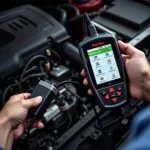Finding the best car diagnostic tool for semi-pro mechanics can be a challenge. With so many options on the market, it’s easy to get overwhelmed by technical jargon and varying price points. Whether you’re a seasoned DIYer looking to upgrade your equipment or a budding mechanic starting your toolkit, this comprehensive guide will help you navigate the world of car diagnostic tools and make an informed decision.
What to Look for in a Semi-Pro Car Diagnostic Tool
Before we delve into specific product recommendations, let’s discuss the essential factors to consider when choosing a car diagnostic tool:
1. Vehicle Compatibility: Ensure the tool supports the make, model, and year of your vehicle(s). Look for tools compatible with a wide range of OBD-II (On-Board Diagnostics II) protocols, including CAN (Controller Area Network) and J1850.
2. Functionality: Determine your diagnostic needs. Do you require basic code reading and clearing, or are you looking for advanced features like live data streaming, bi-directional controls, and special functions?
3. User Interface: Opt for a user-friendly interface with intuitive menus and clear navigation. A color display, ideally a touchscreen, enhances readability and ease of use.
4. Software and Updates: Choose a tool with regular software updates to ensure compatibility with the latest vehicle models and diagnostic protocols. Some tools offer subscription-based updates, while others provide free lifetime updates.
5. Durability and Portability: Consider the tool’s build quality and portability. A robust design with a protective case can withstand the demands of a workshop environment.
6. Price and Warranty: Car diagnostic tools range in price from budget-friendly options to high-end professional-grade devices. Determine your budget and explore tools that offer a balance of features and affordability. A solid warranty provides peace of mind in case of defects or malfunctions.
Top Features for Semi-Pro Mechanics
Here are some key features semi-pro mechanics should consider:
- Live Data Streaming: Monitor real-time sensor data, such as engine RPM, coolant temperature, and oxygen sensor readings, to diagnose issues effectively.
- Bi-Directional Controls: Perform active tests, such as activating solenoids or cycling components, to pinpoint faults and verify repairs.
- Special Functions: Access manufacturer-specific functions, such as ABS bleeding, DPF regeneration, and electronic parking brake service.
- Code Lookup and Definitions: Retrieve detailed code definitions and troubleshooting information directly on the tool or via a connected device.
- Data Logging and Reporting: Record and save diagnostic data for future reference or to share with clients.
Choosing the Right Tool for Your Needs
The best car diagnostic tool for you depends on your specific requirements and budget.
-
DIY Enthusiasts: For basic diagnostics, such as reading and clearing codes, resetting service lights, and viewing live data, a budget-friendly OBD-II code reader with a user-friendly interface might suffice.
-
Aspiring Mechanics: If you’re looking to delve deeper into diagnostics and perform more advanced tasks, consider investing in a mid-range scan tool with features like bi-directional controls and special functions.
-
Mobile Mechanics: Portability and wireless connectivity are crucial for mechanics on the go. Choose a compact tool with Bluetooth or Wi-Fi capabilities to diagnose vehicles remotely.
Conclusion
Investing in the best car diagnostic tool is essential for any semi-pro mechanic. By understanding the key features, your specific needs, and budget considerations, you can choose a tool that empowers you to diagnose and repair vehicles efficiently. Remember to prioritize vehicle compatibility, user-friendliness, and a balance of features and affordability when making your decision.
FAQs
1. Can I use a semi-pro diagnostic tool on any car?
While most semi-pro tools support a wide range of OBD-II compliant vehicles, it’s crucial to check the tool’s specifications for compatibility with your specific make, model, and year.
2. Do I need a subscription for software updates?
Some manufacturers offer free lifetime updates, while others require a paid subscription for ongoing software and database updates. Consider the long-term costs when comparing tools.
3. What are bi-directional controls, and why are they important?
Bi-directional controls allow you to interact with vehicle systems by sending commands, such as opening and closing valves or activating components. This feature is invaluable for confirming repairs and diagnosing complex issues.
4. Can I use a car diagnostic tool to program keys or modules?
Key programming and module coding often require specialized tools and software. While some semi-pro tools offer basic programming functions, it’s essential to consult your tool’s documentation for its capabilities.
5. What is the warranty coverage for most car diagnostic tools?
Warranty coverage varies by manufacturer, typically ranging from one to three years. Some manufacturers offer extended warranties for an additional cost.
Need more assistance? Contact our 24/7 customer support team via WhatsApp: +1(641)206-8880, Email: [email protected]. We’re here to help!


